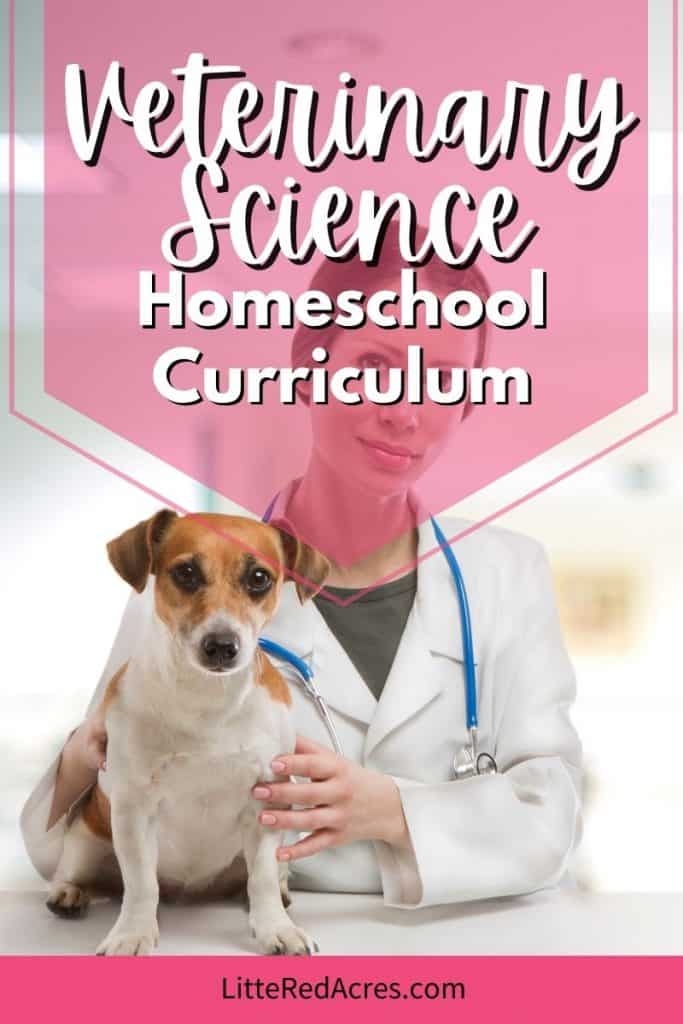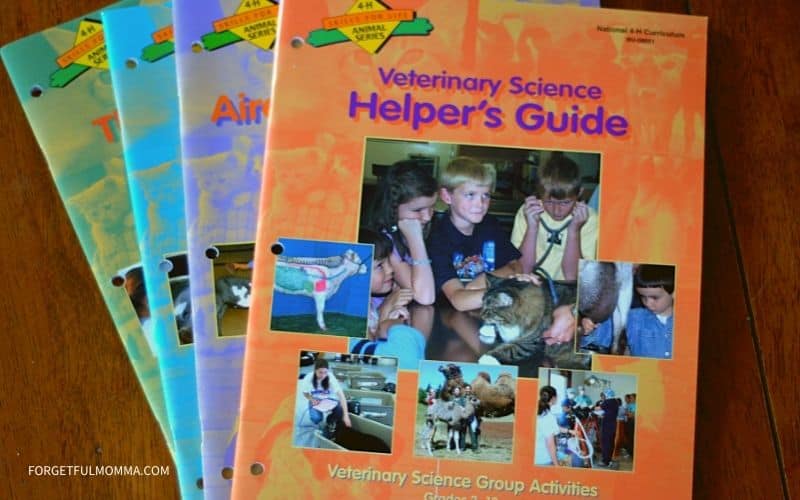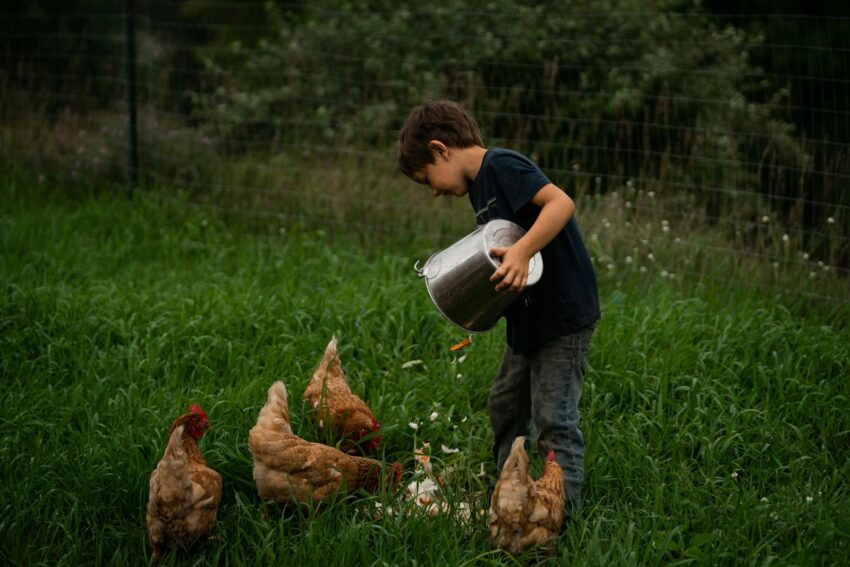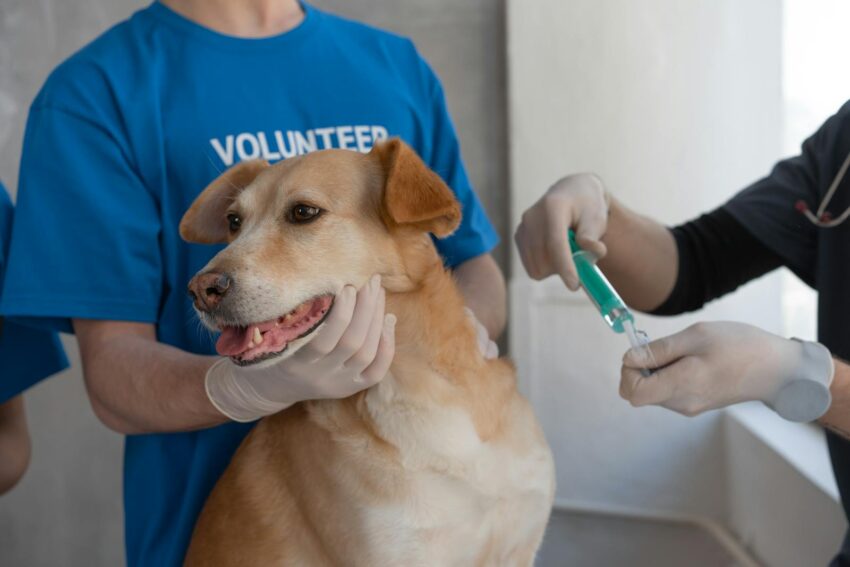A lot of kids dream of becoming a vet when they get older, at least one of my three kids is planning something animal-related, vet or animal conservation officer. Adding in veterinary science seems like a no-brainer in your homeschool.

This post contains affiliate links, see my disclosure policy for more information.
Veterinary Science Homeschool Curriculum
I got extremely excited when I found out about the 4-H curriculum from a local mom. They have so many different options that I can’t believe that I hadn’t learned about their curriculum before.
The 4-H curriculum starts at grade 3 and goes to grade 12. This one is Veterinary Science.
Level 1: Grade 3-5: Introduces youth to the normal animal, basic anatomy and systems, elementary principles of disease, and careers with animals.
Level 2: Grade 6-8: This guide involves youth in an in-depth investigation of normal and abnormal systems, preparation for college, and exploration of the diversity of the veterinary profession.
Level 3: Grade 9-12: This guide involves youth in an in-depth investigation of normal and abnormal systems, preparation for college, and exploration of the diversity of the veterinary profession.
There is also a Helper’s Guide: These supplemental materials provide helpers with activities to facilitate learning for various ages of youth. Numerous group activities help youth develop essential life skills as they pursue their interest in veterinary medicine.

More Veterinary Science Book Options
There are a number of great books that are available on Amazon as well. From coloring books that are quite detailed and labeled. We have a few of these ourselves, and more books that can help your child get ready for their future.
Veterinary Anatomy Coloring Book – Color your way to a complete mastery of veterinary anatomy. Approximately 400 easy-to-color illustrations and corresponding anatomical descriptions guide you through the head, neck, back, thorax, abdomen, extremities, reproductive organs, and many more body parts of dogs, cats, horses, pigs, cows, goats, and birds.
Plus, a new section on exotics takes you through the anatomy of ferrets, rodents, rabbits, snakes, and lizards to ensure you are well versed in all potential household pets.
Introduction to Animal and Veterinary Anatomy and Physiology – A sound knowledge of anatomy and physiology is an essential basis for the effective clinical treatment of companion animals and farm animals alike.
This book provides a comprehensive description of the anatomy and physiology of dogs and cats. The book builds on these foundations with detailed descriptions of exotic small species including birds, and domestic farm animals, including cows, sheep, and pigs, as well as the horse.
Introduction to Veterinary Anatomy and Physiology Workbook – Understanding companion animal anatomy and physiology is the foundation to providing good veterinary care, but the underlying concepts covered in the classroom are not always easy to relate to everyday clinical practice.
How to Become a Veterinarian: What They Do, How To Train, Daily Life As Vet, Is It Really The Right Career For You? – This fact-pact and enlightening book covers everything kids need to know about becoming a vet. It also gives a realistic view of what daily life is like as a vet – the challenges and triumphs.

Additional Benefits of a Veterinary Science Homeschool Curriculum
If you’re considering adding a veterinary science curriculum to your homeschool, you’ll be happy to know it offers much more than just science knowledge. It’s a hands-on, practical subject that prepares your child with skills and confidence for the future.
Encourages Critical Thinking and Problem-Solving
Veterinary science goes beyond memorizing facts—it challenges children to think like real scientists. They learn to analyze symptoms, ask the right questions, and think critically about solutions. These problem-solving skills carry over into math, reading, and everyday life situations.
Inspires Career Exploration
Even if your child doesn’t pursue veterinary medicine, this curriculum opens their eyes to careers in animal care, biology, zoology, and even agricultural science. It’s an engaging way to explore STEM fields that might spark long-term passions.

Teaches Responsibility and Compassion
Learning about animal health naturally builds empathy and responsibility. Children gain an appreciation for the hard work and dedication it takes to care for living creatures, and that respect often extends into how they treat people and their environment.
Builds Hands-On Confidence
From identifying animal anatomy to understanding common health concerns, your child will gain knowledge they can apply in real life. If you have pets at home, they’ll love putting what they learn into practice and may even feel proud of being the “junior vet” of the household.
Flexible and Adaptable
One of the biggest benefits of this curriculum is that it can be scaled up or down depending on your child’s age and interests. Younger children may focus on fun, interactive projects, while older students can dive deeper into biology, anatomy, and health sciences.
Great for Multi-Subject Learning
Veterinary science is a natural way to weave together multiple subjects:
- Math: Calculating dosages, measurements, and growth rates.
- Language Arts: Writing up research, reports, or journals.
- History: Exploring famous veterinarians and the history of animal care.
- Art: Sketching animal anatomy or creating educational posters.
By blending these subjects, your homeschooler experiences a richer, more well-rounded education while having fun with a topic they love.

Hands-On Veterinary Science Activities for Homeschoolers
One of the biggest benefits of using a veterinary science curriculum for homeschoolers is how interactive it can be. Kids don’t just read about animals—they get to explore, create, and experiment in ways that bring lessons to life. These homeschool veterinary science activities are perfect for keeping your child engaged and curious.
Pet Observation Log
Have your child act as the “junior vet” of the family by keeping a daily log of your pet’s health and behavior. They can track diet, exercise, and mood changes. If you don’t have pets, they can observe local wildlife or farm animals. This teaches responsibility, data collection, and scientific observation.
Animal Anatomy Projects
- Label and color diagrams of cats, dogs, or farm animals.
- Build models of organs or skeletal systems with clay or playdough.
- Compare human anatomy to animal anatomy to strengthen understanding of biology.
First Aid Kit for Pets
One of the most popular hands-on veterinary projects for kids is creating a DIY first aid kit for pets. Gather basic supplies like gauze, tweezers, antiseptic wipes, and a digital thermometer. Discuss how each tool is used, giving children real-life applications of their learning.

Math in Veterinary Science
Homeschooling parents love when subjects overlap. Veterinary science makes math fun:
- Calculate feeding amounts based on animal weight.
- Convert units for medication dosages.
- Track a pet’s growth over time with measurements and graphs.
Dissections and Models
For older students, start with a simple flower dissection to practice labeling and identifying structures. Then, move on to safe dissection kits or 3D animal anatomy models for a deeper dive. These activities connect abstract science to real biology.
Field Trips and Virtual Tours
- Visit a local animal shelter, farm, or veterinary clinic.
- Take online virtual tours of zoos, aquariums, or vet schools.
- Field trips reinforce that veterinary science is a real, exciting career path.
Creative Assignments
- Write and illustrate a “How to Care for Your Pet” guide.
- Create posters about preventing common illnesses in animals.
- Role-play running a veterinary clinic using stuffed animals.
Simple Science Experiments
Hands-on experiments make this curriculum even more exciting:
- Study nutrition by testing how plants grow in different soil types or liquids, and relate it to animal diets.
- Demonstrate digestion by observing how vinegar breaks down bread, simulating stomach acid.
By adding these homeschool veterinary science activities, your lessons become more than just reading and worksheets. Children gain practical knowledge, confidence, and compassion—all while having fun. This is the kind of learning that sticks and makes homeschooling rewarding for the entire family.
More Animal Science
Animal science curriculum for your homeschooling might not be a one and done boxed curriculum idea but there are a lot of options for you and your child to learn from.
I have found these great options that we have really enjoyed using that you and your kids might also enjoy using in your homeschool this year.
